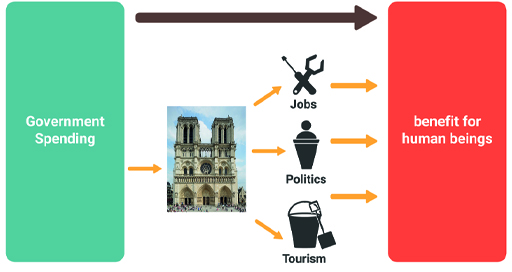2.3 The economic justification for rebuilding
There are two responses that could be made on behalf of the French government. The first focuses on the economic benefits of conserving and restoring heritage. The second, which you will read about in the next section, focuses on ‘heritage values’.
This first response is fairly simple and can be used as a reply to the cost-effectiveness and humanitarian arguments. It goes as follows.
In the long term, the project of restoring Notre-Dame will pay for itself. Through various economic factors, rebuilding Notre-Dame will bring in more income for France than it would cost to carry out. Therefore, it cannot fail to be a cost-effective way of spending funds. Also, it might be the most cost-effective option, bringing in more money than any other project. Thus, ultimately, it would allow for the state to make the greatest investment in the humanitarian causes that are, according to the humanitarian argument, more important.
Activity 5 The economic benefits of Notre-Dame’s restoration
In what ways do you think restoring Notre-Dame could generate economic benefits for the people of France?
Think specifically about the work that would be involved and the achievement that would result.
Discussion
There are a few ways in which the restoration could end up paying for itself. Here are three (you may have thought of others).
- First, the project will be very effort-intensive, requiring many workers, from architects and designers to craftsmen, joiners, and all kinds of administrative and managerial roles. In short, the project will create numerous jobs. And these jobs will have various knock-on benefits, reducing the strain on welfare and, as the workers spend their wages, stimulating the economy and creating further tax revenue.
- Second, the restoration of Notre-Dame will bring in a lot of revenue by attracting tourists who will spend money in local restaurants, hotels and businesses. This adds to the income of the French government through both taxes and the invigorating impact of tourism on the local economy. Without Notre-Dame, fewer tourists would travel to Paris or spend less time (and money) there. Preserving and eventually restoring the cathedral to its former glory would presumably retain these tourists and potentially attract even more.
- Third, the state’s commitment to the project, and the final outcome of a fully restored Notre-Dame, may also serve valuable political ends. It is reasonable to suppose that France owes at least some small portion of the respect it receives to its impressive store of cultural heritage, of which Notre-Dame is a key element. Hence, the reconstruction may succeed in enhancing France’s image on the global stage and even promote the self-esteem of French citizens. Such consequences would probably bring economic benefits, even if they are hard to quantify precisely.
Figure 14 summarises the economic justification for rebuilding. The upshot of this is that spending on cultural heritage could be an investment that pays back more than was put in. Hence, it will be cost-effective. Also, it may provide greater benefits and economic returns than any other option. In this case, even if the explicit goal is to help people, it may be better to spend money on restoring Notre-Dame than on anything else. Overall, the various advantages that come from such heritage investment would produce the greatest benefit for human beings, so that is what should be done.
And yet, a crucial feature of the economic justification is that it predicts the likely consequences of spending money on restoring Notre-Dame. The success or failure of this argument rests entirely on whether such predictions are true.
It is conceivable that the predictions it makes are accurate, and that heritage-spending could produce a net benefit overall. On the other hand, it is also conceivable that there are other projects which would produce even more of a net benefit, such as investment in transport infrastructure, or even building a new sport stadium. If so, while the restoration would still be cost-effective, tax funds would be better spent elsewhere.
In addition, Notre-Dame’s restoration might not even be cost-effective. It could produce some advantages but they would not outweigh the cost of the project. If this were true, the cost-effectiveness argument would collapse. Therefore, if this justification is deployed, it is critically important that its predictions are tested and assessed for their accuracy.

